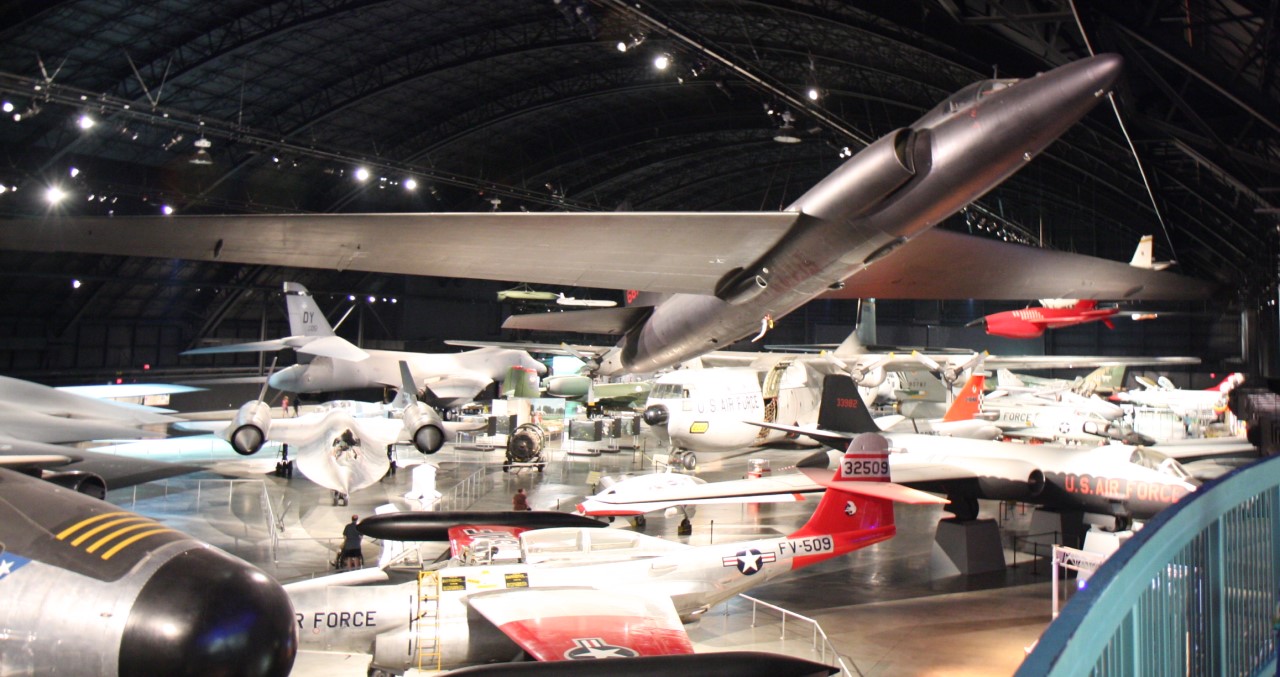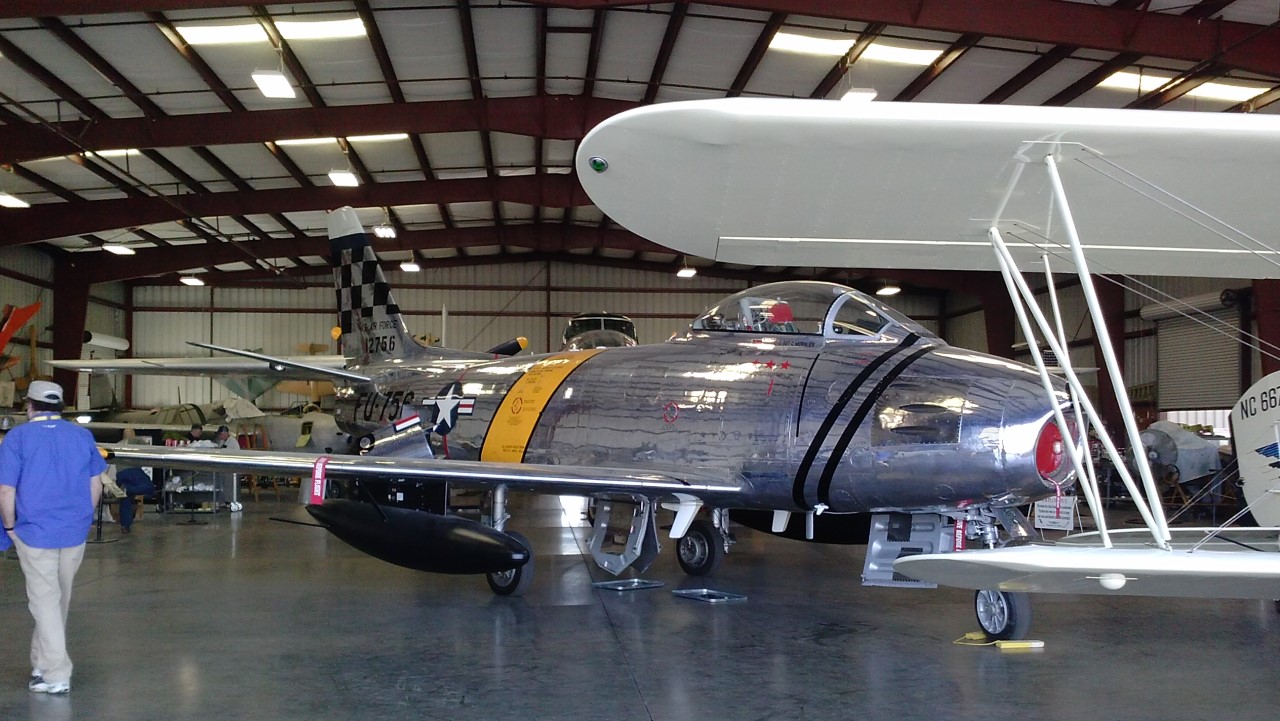As is well known to readers of this site, I am a connoisseur of military museums of various types. And in my visiting of every museum I pass by that Lord Nelson doesn't drag me away from, I've noticed a problem. Most air museums aren't very good, because planes are big.

The basic problem is simple. It's very rare to find an artifact (broadly defined) which can hold a typical visitor's interest for more than 30 seconds, maybe a minute at the outside. Which is fine if your museum is full of small things (Roman weapons, paintings, 16th-century dresses, Pokemon plush) so you can put dozens into each room. But this poses an obvious problem for air museums, whose artifacts are each the size of a room. A few museums (Dayton, Pima and Udvar-Hazy spring to mind) are able to bury this problem under the sheer number of planes they have, but most museums can't do that. A typical small air museum has at most a dozen planes, and even if they try to stretch their artifact count with an engine here and a flight suit there (as most of them do) that's still maybe a half-hour visitor experience.
I think the solution here is to treat each plane not as a single artifact, but as the centerpiece of a miniature exhibit. Look at other types of museums. Sure, there's the headline thing that they advertise and build the exhibition around, but it's not just plonked in a gallery with a sign next to it. There's supporting artifacts on the way in and out, and lots of signage to tell the story. The only air museum I've been to that gets this really right is the Air and Space Museum on the Mall. They're short on space, so each gallery is a couple planes and a lot of other stuff around whatever the subject is. The Wright Flyer Exhibit is perhaps the best example to take inspiration from, as it's built around a single plane, but it's also worth paying a visit to American History down the Mall and seeing what they've done with the Star-Spangled Banner exhibit.
To make this more concrete, say you ask me to display a P-51.1 I'm going to start by seeing if I can wrangle a Merlin and a V-1710 and put both under one wing, with a sign talking about the differences and the engine swap. The other wing will have a display on armament, with an M2 and some dummy bombs and rockets, maybe a gunsight if we can lay hands on one. But the big thing that I don't think I've seen anyone do well is models. Have a lot of them, each with a specific relation to the plane. A B-17, Bf 109 and Fw 190, with discussion of air combat over Germany. A selection of P-51s showing the different nations and theaters it served in. And a P-40, P-47, Mustang I, P-51A, P-51B, P-51D, P-51H, P-82, A-36, FJ-1 and F-86 to show the development of the family and the alternatives around at the time. Now instead of one artifact, there are a dozen or more, each of which can deliver its own informational payload.2 I'm able to keep the visitors entertained for a lot longer in the same space, and they learn more and probably have a better time.

In my experience, air museums that take great pride in flying their planes tend to be the worst about guest experience. Some of this is undoubtedly operational, as the need to be able to move planes around would make it difficult to build large, complex displays. But I suspect a lot of it is cultural. They view flying the planes as their primary job, and a good guest experience is secondary. I'm not arguing that we should ban museums from flying planes (if nothing else, it may well pay dividends in volunteer and donor support), but it definitely seems worth keeping in mind as a potential visitor.
Now, the obvious question is how this applies to the museum ship world, and I think it mostly doesn't. First, a museum ship isn't a single artifact, it's a collection of them. A typical museum airplane is a big lump that you take in all at once, while a museum ship has multiple rooms and lots of smaller things to look at. If nothing else, museum ships tend to lean hard into selling the ship as a series of smaller vignettes, with separate stations on all sorts of things. Second, it's not just a collection of rooms, it's an immersive environment. A lot of the experience is being in a space that is alien to you but designed for people, "here is a place" rather than "here are some things". This makes museum ships far more like historical buildings rather than typical "objects in a room" museums that air museums are clearly a subtype of, although air museums that let visitors inside planes can take advantage of the same effects.

Comments
Another way museum ships are different, which is related to the points you raised, is that a ship is designed to be populated by dozens, hundreds, or thousands of people who are regularly walking around and doing things. This facilitates a substantial number of visitors also simultaneously walking around the ship as a museum and looking at things. And airplane, OTOH, is generally crewed by a single pilot or a handful of people at most and is generally designed for them to be strapped into their seats most of the time, so the space is designed for zero or at most 1-2 people to be walking through it at any given time.
I haven't visited one in ages, but (IIRC) railroad museums have the same problem. The PA RR museum and B&O RR museum both have gigantic rolling stock collections, but I always spent much more time in adjacent exhibits instead, precisely because the displays were so much more information-dense.
I think some of it is also that a lot of the time they just have the plane on display as 'look at this cool fuselage' - if it's hanging up or otherwise out of reach that's all you can do, but I think especially on the engineering side there's more you can do to split a plane from 'here's a plane' to 'look at the landing gear and the avionics and the bomb rack and the [...]' to draw out some of the unique features of the plane.
Also, some museums do it better than others, but it seems like there is a bit of tension between emphasizing 'this is a museum of technical achievements' and 'this is a museum of (military) history'.
The French Air and Space Museum in Paris is very well laid out. Probably in my opinion the closest to your ideal. Models, artifacts grouped by time period with supporting information as well of smaller items related to the time period/item showcased in the exhibit.
An interesting alternative is at the Boscombe Down Aviation Collection, where they have some planes, but a LOT of cockpits from other planes, and you can sit in all the cockpits.
Unfortunately the Harrier GR3 was not of my size...
The Royal Naval Air Museum in Yeovil in the UK is really well worth a visit - lots of planes, signage, talks by staff on planes and helicopters (as in, THIS helicopter dropped the SAS off on the Falkland Islands, and these are the bullet holes from that mission).
And they have a Concorde prototype.
No air-dropped nuclear torpedoes; maybe that's in the workshop out back...
The best ones I've been to - Duxford, Shuttleworth, Hendon - solve the problem by being huge, with vast collections including working restoration shops.
Also, in the case of Duxford, also by being a very active airfield, both general aviation and warbirds. The first time I was there my sone dragged me out of one of the hangars to watch a Spit and a 109 playing tailchase. Not a scheduled event as far as I could tell, just a couple of pilots who felt like going up for a play.
Shuttleworth was a poor weather day midweek when I went, so no flying. But, so I'm told, on very still & dry summer evenings one of the few places in the world you can regularly see >100 year old aircraft actually flying.
Slightly belated response to everyone here:
There are a lot of cool things air museums could do, and if I was placed in charge of one, this stuff would only be my first step. But I was trying to focus on things that are easy and scalable, not stuff that is either inherently unscalable (having lots of airplanes) or that requires a lot of specialized work to do. Yes, I am amazed that I've never seen air air museum do essentially a cutaway of, say, a bizjet. There was actually an airliner that they'd done that to in the parking lot of the first building I worked in, and it was really cool. You'd need to make sure that there were no sharp corners if you were to let the general public in, and add signage. But that would be expensive and time-consuming. Likewise things like opening up cockpits.
@Jacob
I avoid rail museums, because I suspect that trains are an infohazard, and I have enough hobbies. But I can easily see them having the same issue.
The Virginia Air & Space Center (in Hampton, not to be confused with the Udvar-Hazy center near Dulles) does a pretty good job with this. They have a complete DC-9 airliner with most of the interior open to the public, including the cockpit. You can sit in the cockpit, move the yoke and rudder, mess with buttons, etc. Their spacecraft exhibits are interspersed with interactive games, like a space shuttle landing "simulator".
Worth a visit if you're ever in the area. You could also tack on a visit to the Wisconsin just across the James River, and Fort Monroe 3 miles away.
The US Army Transportation Museum up the road in Fort Eustis is also very underrated. In keeping with the fine traditions of the Army Museum Enterprise, it has no marketing, a minimal web presence, and is hidden behind a scary-looking base gate. But they have a huge collections of 100+ vehicles, including ground vehicles, watercraft, trains, and aircraft. Pretty cool spot.
First, the Virginia A&S Museum. My wife and I visited it in the mid 2010's and did an article on it for a UK model magazine. Really nice people there, happy to talk "airplanes" to visitors. They let us step over boundary ropes, to get up close to the planes. It's small, and a pain to get to (twisty roads!), but well worth the time. We also visited the Navy air museum at Pensacola. Lots of very interesting planes, but very poorly laid out. Planes overlap so much you can't step back and see a single one, without having to look around another (or a building support).
One museum we heartily recommend is the Beechcraft museum in Tullahoma. Visitors are treated like adults. Sign in and you're allowed to walk around the displays, trusted not to harm them. No stand-offs, no barriers.
VASC was able to raise a ton of money after the movie Hidden Figures came out in 2016, so they've pretty dramatically updated the space since the mid-2010s.